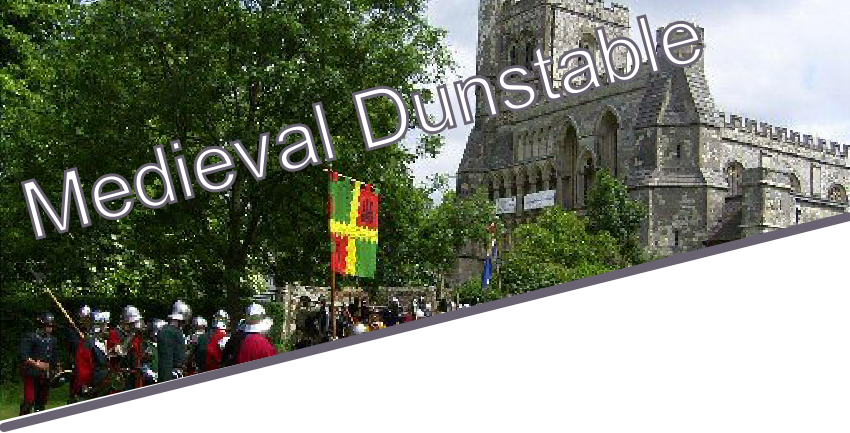
Medieval Dunstable© Webmaster Helen Mortimer Privacy Policy | Terms of Use



Royal Visits to Dunstable
Author Vivienne Evans
When, around 1107, King Henry I founded his business centre on Dunstable crossroads he included a small palace for use when he was travelling. It may have been during his first visit c1109 that he decided to found an Augustinian Priory opposite his palace. The church of this priory was near enough finished for him to choose Dunstable as a suitable place to hold his 1122 Christmas court. He held a second Christmas court there in 1131 and King Stephen did the same in 1136. Stephen and the barons were at Kingsbury in 1154 for a peace conference, as a result of this Henry II, Matilda’s son was crowned king the following year.
Over the centuries there were many royal visits; King John was a regular visitor, and he must have decided that Kingsbury was too expensive to maintain, and in 1204 on a visit, he gave to the Priory ‘the site and garden’ where King Henry I ‘once had houses’. John passed through again in 1215.
King Henry III and Queen Eleanor made several visits. In 1229 Henry mediated between the Prior and the townspeople, and in 1247 stayed there with all his family, leaving silk cloths and 100 shillings, gifts to be used in the church. The Prior in return gave each a gilt cup. He visited again 1266 and 1267.
Both King Edward I and Queen Eleanor stayed in Dunstable in 1275 and 1276. A particularly spectacular occasion must have been the arrival of Queen Eleanor’s funeral procession on December 12th 1290.
King Edward I, accompanied by the prior and other senior figures of both church and state, would have led the solemn procession in through the great Norman arched west doorway, up the centre of what is now the parish church, but at that time was the nave of the canon’s church, and into their chancel where it rested overnight before the high altar.
In 1326 Queen Isabella came, and Edward III stayed here three times. In 1459 Henry VI was here.
King Henry VIII, Catherine of Aragon and Anne Boleyn all visited Dunstable Priory, but none of them were there for the ‘royal’ event for which Dunstable is most well-known. In their absence on 23rd May 1533, Archbishop Cranmer published his and his committee’s decision that Henry’s marriage to Catherine had never been legal and had therefore been annulled. This meant that Henry’s recent marriage to Anne Boleyn was legal, and that they could prepare for her coronation.
Henry VIII visited both before the Dissolution in 1537, when he refused to stop at the priory, staying instead at a town inn, and again after the dissolution in 1540 and 1541.
| Archaeology |
| Audio Guides |
| Education |
| Exhibitions |
| Events 2013 |
| Physic Garden |
| Priory History |
| Priory Churches / Lands |
| Town History |
| Virtual Tour |
| Website |
| Archaeology |
| Charters & Bylaws |
| Eleanor Cross |
| Famous People |
| The Fraternity |
| Friary |
| Guided Tours |
| History |
| Inns |
| Dunstable Treasures |
| Kingsbury |
| Middle Row |
| Royal Visits |
| Sheep & Wool Trade |
| The Town |
| Friary Archaeology |
| Bone Study |
| Friary |
| Annals Charters Valor Ecc |
| Archaeology |
| Churches and Lands |
| Guided Visits |
| Audio Guides |
| History |
| Monastic Life |
| Virtual Tour |
| The Augustinian Priory |
| The Canons Route |
| Bedfordshire |
| Buckingham |
| Derbyshire |
| Nothamptonshire |
| Hertfordshire |
| Leicestershire |
| Oxon |
| Priors |
| Annulment |
| History |
| Archives |
| Book Sales & Shop |
| Exhibitions |
| Guided Walks |
| Heritage Talks |
| Physic Gardens |
| Schools |
| Tourist Information Centre |
| Tea-room |
| Visits |
| Priory House Heritage Centre |
| Education |
| Knight |
| Search Results |